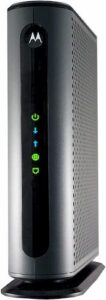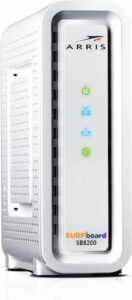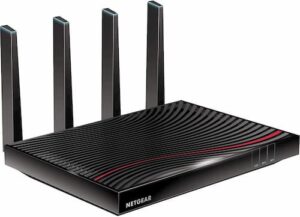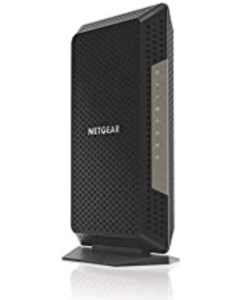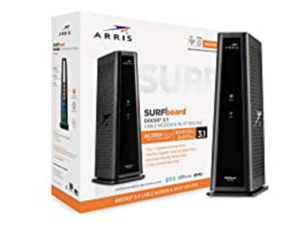Modems
Best Modems for Gigabit Internet 2021
- Best overallMotorola MB8600
- $149.99
- Gigabit Ethernet ports: 2
- Channel bonding: DOCSIS 3.1 and 32×8 in DOCSIS 3.0
- ARRIS SURFboard SB8200
- $180.90
- Gigabit Ethernet ports: 2
- Channel bonding: DOCSIS 3.1 and 32×8 in DOCSIS 3.0
- Best modem/router comboNETGEAR Nighthawk C7800
- $349.98
- Gigabit Ethernet ports: 2 (plus 2 USB ports)
- Channel bonding: DOCSIS 3.1 and 32×8 in DOCSIS 3.0
- Best lookNETGEAR Nighthawk CM1200
- $178.90
- Gigabit Ethernet ports: 4
- Channel bonding: DOCSIS 3.1 and 32×8 in DOCSIS 3.0
- Best app controlsARRIS SURFboard SBG8300
- $291.15
- Gigabit Ethernet ports: 4
- Channel bonding: DOCSIS 3.1 and 32×8 in DOCSIS 3.0
Our top pick: Which gigabit modem is best?
The best overall gigabit modem in our opinion is the Motorola MB8600. It meets DOCSIS 3.1 standards, comes with four gigabit Ethernet ports to let you boost your speeds through link aggregation, and it’s backwards compatible for DOCSIS 3.0 (the previous cable internet standard). It also comes at a reasonable price compared to other DOCSIS 3.1 modems with fewer features.
The 5 best modems for gigabit internet
- Motorola MB8600: Best overall
- ARRIS SURFboard SB8200: Best value
- NETGEAR Nighthawk C7800: Best modem/router combo
- NETGEAR Nighthawk CM1200: Best look
- ARRIS SURFboard SBG8300: Best app controls
Best modems for gigabit internet
| Model | Price* | Ethernet ports | Warranty | ||
|---|---|---|---|---|---|
| Best overall | Motorola MB8600 | $149.99 | 4 | 2-yr. warranty + phone and web support | View on Amazon |
| Best value | ARRIS SURFboard SB8200 | $180.90 | 2 | 2-yr. warranty + phone and web support | View on Amazon |
| Best modem/router combo | NETGEAR Nighthawk C7800 | $349.98 | 4 | 2-yr. warranty + 24/7 tech support for 90 days after purchase | View on Amazon |
| Best look | NETGEAR Nighthawk CM1200 | $178.90 | 4 | 1-yr. warranty + 24/7 tech support for 90 days after purchase | View on Amazon |
| Best app controls | ARRIS SURFboard SBG8300 | $291.15 | 4 | 2-yr. warranty + phone and web support | View on Amazon |
What should you look for in a modem for gigabit internet?
Before you buy your sexy new 1,000 Mbps modem, keep these factors in mind:
- The modem must be compatible with your ISP (internet service provider). Check the tech specs or call your ISP just to make sure.
- Multiple ports allow for advanced activities. Use the gigabit Ethernet ports on the back to set up link aggregation or connect multiple IP addresses.
- Product warranties help with technical issues. Register the modem and call up customer support if there’s ever a glitch in the hardware.
Motorola MB8600—Best overall
$149.99
- Channel bonding: DOCSIS 3.1 and 32×8 in DOCSIS 3.0
- Gigabit Ethernet ports: 2
- Compatible providers: Xfinity, Cox
The Motorola MB8600 certainly has some impressive numbers behind it. Four gigabit Ethernet ports? Maximum 3.8 Gbps download speeds? Way cool.
There’s something you should know though. Most internet providers can barely break the 1 or 1,000 Mbps) mark at this point, so claims of 3.8 Gbps download capacity are more aspirational than anything—it’ll take some time before a cable internet provider will be capable of breaking such Wi-Fi speed records.
As for the four Gigabit Ethernet ports, well, to be honest, they’re not really necessary for most users. You can’t use them to connect multiple client devices, for example—you’ll still need a router for that.
But what you can do is pretty cool. The ports are specifically designed for users to set up a link aggregation group—or LAG—in which you use multiple Ethernet connections between a modem and router to boost an internet signal past 1 Gbps speeds.
The ports can also be used to support multiple IP addresses on one network, which comes in handy if you have a home office where you’re hosting a website or running an FTP server.
It’s these extras that make us consider Motorola’s MB8600 one of the best gigabit modems around. Gamers who livestream can use it to ramp up speeds along with their high-performance routers. Average users can use it to prep for the days of faster Wi-Fi. And since this modem costs roughly the same as other DOCSIS 3.1 modems with fewer gigabit Ethernet ports, having four ports instead of just one or two is the icing on the cake.
Pros
- Four gigabit Ethernet ports
- Excellent Broadcom chipset
Cons
- Bulky design
- Limited compatibility with providers
ARRIS SURFboard SB8200—Best value
$180.90
- Channel bonding: DOCSIS 3.1 and 32×8 in DOCSIS 3.0
- Gigabit Ethernet ports: 2
- Compatible providers: Xfinity, Cox, Spectrum
ARRIS was the subject of a class-action lawsuit in 2017 over complaints about the bug-laden Puma 6 chipset in its modems.
Judging from online forums and reviews, people are still shaking their heads over the Puma 6 debacle, which also affected other modem makers and compelled ARRIS to install Broadcom’s superior BCM3390 silicon components into the SB8200.
The SB8200 is the latest in ARRIS’s respected SURFboard series. It boasts a utilitarian look, with its boxy shape and straightforward color schemes (you can order it online in either white or black). Behind the blinking LED lights and ventilated chassis, there are 3 GB of RAM, 128 MB/16 MB of flash memory, and 32 downstream and 8 upstream channels.
All in all, it’s a formidable 1,000 Mbps modem that can reach even greater speeds in a DOCSIS 3.1 system. And it will still deliver silky-smooth video streams in 4K video quality when working under DOCSIS 3.0. As a bonus, ARRIS’s SURFboard Manager app lets you monitor and manage your Wi-Fi network from afar with your smartphone or tablet.
Pros
- No more Puma 6 chipset
- Multiple color options
Cons
- Fewer Ethernet ports
- Limited compatibility with cable providers
NETGEAR Nighthawk C7800—Best modem/router combo
$349.98
- Channel bonding: DOCSIS 3.1 and 32×8 in DOCSIS 3.0
- Built-in router: Dual band Wi-Fi, 2.4 and 5GHz
- Gigabit Ethernet ports: 2
- USB ports: 2
- Other features: Guest network access, free customizable URL
- Compatible providers: Xfinity, Spectrum, Cox
Just as the awe-inspiring name suggests, the Nighthawk C7800 is a formidable beast built for serious gamers and ’net users. This gigabit modem router combo comes out of NETGEAR’s famed Nighthawk hardware series, acclaimed for delivering not just fast gaming speeds but also firewall protection against hackers.
The C78800 delivers dual-band Wi-Fi and works for both DOCSIS 3.1 and DOCSIS 3.0. The four trusty gigabit Ethernet ports will let you set up link aggregation to push past 1,000 Mbps speeds, so long as your cable company has the capacity for higher-speed gigabit plans.
The Nighthawk also provides double firewall protection and 128-bit encryption, protecting your home network against DDoS attacks and other cybercrime shenanigans. You can even set up a guest network to provide Wi-Fi for friends, loved ones, and party crashers while keeping your own system safe from the malware that could be lurking on their phones or laptops.
The Nighthawk does come at a significantly heftier price tag than the other options, but in most cases you’ll still save anywhere from $50 to $100 if you bought this instead of a DOCSIS 3.1 modem and an upper-tier router separately. If you need excellent performance at a decent price, this isn’t a bad way to go.
Pros
- Built-in Wi-Fi router
- Secure network to prevent hacking
Cons
- Expensive
- Incompatible with some cable providers
NETGEAR Nighthawk CM1200—Best look
$178.90
- Channel bonding: DOCSIS 3.1 and 32×8 in DOCSIS 3.0
- Gigabit Ethernet ports: 4
- Compatible providers: Xfinity, Spectrum, Cox
The CM1200 is basically a newer, slightly more deluxe version of NETGEAR’s CM1000, one of the most popular gigabit internet modems around.
Where the two differ is in how the CM1000 had only one gigabit Ethernet port, while the CM1200 has four—putting it in league with the Motorola MB8600 (albeit at a higher price).
Either the CM1000 or its big brother will work well, as both are solid pieces of hardware geared for DOCSIS 3.1 standards. They’re also both backward compatible for DOCSIS 3.0. But the CM1200 gives you those extra three ports—an advanced feature if you need it.
The CM1200 has a one-year warranty, putting it behind competitors from other brands. However, it’s easily the best-looking modem of the bunch. Well-ventilated and unobtrusive, it weighs in at just .84 lb. The elegant, diamond-angled edges evoke images of obsidian treasures and interstellar spaceships.
It’s rare to meet someone who still uses a landline phone these days, but NETGEAR has you covered if you do need a modem that can work with bundled phone services (i.e., an internet package that also provides support for phone lines). NETGEAR’s slightly more expensive Nighthawk CM1150V is basically the CM1200 but with voice/phone support included.
Pros
- Slick, unobtrusive appearance
- Easy setup
- Lots of Ethernet ports
Cons
- Costs more for average features
ARRIS SURFboard SBG8300—Best app controls
$291.15
- Channel bonding: DOCSIS 3.1 and 32×8 in DOCSIS 3.0
- Gigabit Ethernet ports: 4
- Built-in router: Dual-band at 2.4 and 5 GHz
- Compatible providers: Xfinity, Cox
The ARRIS SURFboard SBG8300 is a DOCSIS 3.1 modem with a dual-band Wi-Fi router attached. In that respect, it’s pretty much just like NETGEAR’s Nighthawk C7800, only without the Nighthawk’s red, wavy stripe, cool antennas, or added security features.
The big bonus here is that you can save on space in your home and maybe a little money by opting for a gigabit modem router rather than having to shop for both a modem and a router.
If having enough room is an issue for you—for example, maybe your 86-inch 4K TV set takes up the lion’s share of space in your 200-square-foot studio—then go for the SBG8300.
This modem/router is approved to work with Xfinity and Cox internet plans. But it won’t work with Verizon, AT&T, or CenturyLink internet plans. ARRIS is waiting on approval from Spectrum and other cable companies, so make sure to check with your ISP if this will be compatible before spending your hard-earned cash.
Pros
- Offers convenient network management
- Saves on space
Cons
- High cost
- Limited compatibility with ISPs
- Fewer security options
Gigabit modem specs and features
If you’ve been nodding your head politely and pretending to understand the whole DOCSIS thing but still haven’t quite figured it out, don’t worry—it took us a while to figure it out too.
When most people think “Wi-Fi,” the last thing they’re probably thinking about is the latest in international data transfer standards. But that’s exactly what DOCSIS is. The term stands for “Data Over Cable Service Interface Specifications,” and it’s a catchy way to describe the vast systems of telecom infrastructure and access controls responsible for routing internet data through coaxial cable networks.
DOCSIS has evolved quite a bit since it first launched in 1997. DOCSIS 3.1, the latest version of this technology, came out in October 2013. Cable companies were excited because it opened the possibility for achieving gigabit speeds as fast as 10 Gbps (10,000 Mbps) over cable lines. In technical terms, experts would describe this as “insanely super-duper fast.”
DOCSIS 3.1 compatibility
Internet service providers haven’t hit those 10 Gbps just yet—most companies offer residential internet plans with 1 Gbps speeds maximum, while Xfinity’s Gigabit Pro package promises to take you to 2 Gbps.
The limited speeds are because not everyone has adapted to DOCSIS 3.1. But switching over to DOCSIS 3.1 is a lot more affordable on the ISP’s end compared to building a new network of fiber-optic lines—it’s like installing new tires for a car versus building an entirely new car from scratch.
Sooner or later, faster speeds will be an option, and when that happens, you’ll be happy you got a gigabit cable modem compatible with DOCSIS 3.1.
Most modems nowadays meet the standards of DOCSIS 3.0, and the higher-end ones can deliver 1 Gbps download speeds, according to the organization behind the DOCSIS protocol.
But having a modem that meets DOCSIS 3.1 standards means you’ll have the hardware necessary to transmit data at much higher capacity. It lets you hit the 2,000 Mbps download speeds allotted in Xfinity’s Gigabit Pro package, and it will give you even more when the day comes that there’s 3 Gbps, 4 Gbps, or even 10 Gbps home Wi-Fi plans.
DOCSIS 3.0 backward compatibility
So now that DOCSIS 3.1 is around, we can ditch DOCSIS 3.0, right?
Not quite. DOCSIS 3.0 came out in August 2006, but it’s still widely in use and far more common than DOCSIS 3.1. If it doesn’t work out between you and your shiny new gigabit plan, you’ll still want a cable gigabit modem that’s backward compatible for DOCSIS 3.0.
As you’re eyeballing options and thinking about which is the best modem for gigabit internet, look for a modem that works under both standards. Ideally you want one that can deliver 32 upstream and 8 downstream channels in DOCSIS 3.0, letting you hit 1 Gbps speeds (or something close) even under that standard.
Gigabit Ethernet ports
As for the gigabit Ethernet ports, you might think in terms of basic math: the more gigabit Ethernet ports a modem has, the more options there are to plug in devices to deliver internet, right? Actually, that’s not the case. Those ports aren’t for plugging things in—they’re for boosting the network speed.
The ARRIS SB8200 boasts two gigabit Ethernet ports. Motorola’s MB8600 has four. However, both modems support a connection for only a single client device.
Where those ports come into play is running multiple Ethernet cables between the modem and your router. This is called link aggregation, which is when you combine multiple network connections to create a single, stronger transmission, allowing you to push beyond 1,000 Mbps download speeds.
Pretty cool, huh? Just make sure you have a cable internet plan that supports the speeds you’re aiming for.
Our verdict: A gigabit modem is worth it
If you ask us, the Motorola MB8600 is clearly the best modem for gigabit internet currently on the market. It’s compatible with DOCSIS 3.1 and DOCSIS 3.0, it has four gigabit Ethernet ports for advanced uses, and it’s a decent price compared with similar modems.
FAQ about gigabit modems
What is the best gigabit modem?
The Motorola MB8600 is the best modem for cable internet speeds of 1,000 Mbps or faster. It’s compatible with DOCSIS 3.1 standards, has four gigabit Ethernet ports for link aggregation, and delivers 32×8 channel bonding if used on a DOCSIS 3.0 network. It’s the best bang for your gigabucks.
What gigabit modems are compatible with Xfinity?
These modems are all compatible with Xfinity gigabit internet plans:
- Motorola MB8600
- ARRIS SURFboard SB8200
- NETGEAR Nighthawk C7800
- NETGEAR CM1000
- NETGEAR CM1200
- ARRIS SURFboard SBG8300
Each of them can reach the 2 Gbps (2,000 Mbps) speeds through Xfinity’s Gigabit Pro package.
What modem do I need for gigabit internet?
To get the best out of your gigabit plan, you’ll need a cable modem that’s compatible with DOCSIS 3.1, the latest version of DOCSIS cable company standards. This will allow you to achieve 1–2 Gbps (1,000–2,000 Mbps) speeds with ease and will also set you up for when even faster speeds are available through cable internet service providers.
Do I need DOCSIS 3.1 for gigabit internet?
You don’t technically need DOCSIS 3.1 to achieve 1 Gbps (1,000 Mbps) download speeds. According to some experts, you can achieve those speeds with a DOCSIS 3.0 modem. But a modem compatible with DOCSIS 3.1 will ensure that you reach 1 Gbps speeds and beyond.
Disclaimer
Product prices and availability are accurate as of the date/time indicated and are subject to change. Any price and availability information displayed on Amazon.com at the time of purchase will apply to the purchase of this product. HighSpeedInternet.com utilizes paid Amazon links.
CERTAIN CONTENT THAT APPEARS ON THIS SITE COMES FROM AMAZON.

